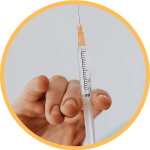PRP (platelet-rich plasma) therapy has become increasingly sought after in aesthetic medicine. By using its regenerative capabilities particularly when it comes to skin rejuvenation and/or hair restoration, this aesthetic treatment is minimally invasive wherein the concentrated platelets and growth factors extracted from a patient’s blood can heal their body’s tissue through cell regeneration. Yet, every PRP treatment has its challenges as well, depending on how it is being centrifuged to separate the blood and plasma containing the platelets.
To ensure the safety of our patients and to get the maximum benefit from PRP treatment, it is essential that we as aesthetic practitioners, including dermatologists, plastic surgeons, cosmetic nurses and medical aestheticians, know what could be the potential PRP therapy complications. The purpose of this article is to identify known or potential complications associated with PRP therapy and offer theoretical interventions that could be incorporated into your clinical settings. This may help to decrease risks associated with PRP therapy and also increase efficacy rates, ensuring patient satisfaction.
Understanding PRP Therapy
A PRP therapy draws a small amount of blood from the patient and then separates plasma which contains the platelets. These platelets release growth factors that help with tissue healing and regeneration. PRP therapy is also widely used for aesthetic applications such as skin rejuvenation, a scar treatment, especially those from acne and in hair loss, but also to improve the results of aesthetic procedures.
There are three main processes involved in PRP collection and processing:
- Blood draw: A trained nurse takes out the patient’s blood to be sent away for testing, usually 10-60 mL.
- Centrifuging: Centrifuging is a stage in which our blood will be set in a centrifuge device that spins at high speed. This resuspends the platelets in a small amount of plasma and separates them from the blood.
- Platelet retrieval: A trained doctor will finally extract the concentrated platelet that is then ready for the area of treatment.
Note: The efficacy of PRP therapy is dependent on the quality of a prepared PRP, which can be achieved and determined through the technique and apparatus used for preparation as well as by adherence to established protocols from the manufacturer.
Common Complications of PRP Therapy
Although PRP therapy is beneficial, it also carries a certain risk of complication. Some PRP issues that a practitioner can generally face, include:
- Infection risks
Injections should be sterile, but as with any injection site, infection can be a big concern. Improper handling or sterilisation of the treatment area or a poor injection technique can lead to infection. PRP therapy complications resulting from using equipment that is not sterile or working in a non-sterile environment can have serious implications for patient safety.
- Pain or swelling at the injection site
Injection technique and skin sensitivity are the two biggest factors, which can influence post-injection pain and swelling, creating a wide spectrum of symptoms. Improper technique or wrong needle size can make this an even more painful process.
- Suffering from allergic reactions or skin sensitivity issues
Side effects of PRP injections may include occasional allergic reactions or increased skin sensitivity in certain patients. This could be considered as an effect of some additives in PRP preparation or it might possibly vary between individuals.
- Failure as a result of bad PRP quality
The quality of PRP is a crucial determinant of treatment outcomes. The technique to process the blood, centrifuge speed and time of injection from collection until it is used can influence platelet concentration and, thus, efficacy.
Potential factors causing the above issues
- Patient health: Patients with some health conditions or taking medications that thin the blood may also be at higher risk of PRP therapy complications.
- Injection technique: Doctors who carry out the injection must be valid and certified to minimise pain, swelling and risk of infection.
- High-quality PRP equipment: The use of FDA-approved and high-quality PRP equipment and apparatus is essential in ensuring that the preparation of PRP reaches its maximum potential.
Best Practices for PRP Preparation
To get the best possible quality of PRP, with minimal to no complications, we recommended using only FDA-approved PRP equipment. Without FDA-approved centrifuges and other equipment, the consistency of PRP will fall by the wayside. Be mindful to always follow the protocols of PRP preparation according to those laid out by a manufacturer.
In addition, maintaining the strictest adherence to sterility is required. This includes the use of sterile gloves, needles in addition to other items during preparation and injection to reduce the risk of an infection.
Lastly, it is important to understand the different PRP preparation protocols. Ideally, the platelet concentration in the PRP prepared should reach its maximum for therapeutic effect. Always optimise platelet counts and it should never be less than what is required based on the protocol. This can be avoided by controlling the centrifugation speed and time cautiously, which takes training and experience to acquire high-quality platelets.

Injection Techniques to Minimise PRP Therapy Complications
Optimal injection methods are essential to reduce PRP complications such as:

Selecting the right needle size
The choice of needle size can greatly impact patient comfort and results. Smaller needles may be a bit more comfortable, but injections placed further down within the tissue often require larger gauge needles.

Pain-reducing approach
The use of topical anaesthetic creams and micro-cannula techniques can drastically reduce inflammation and the discomfort experienced during PRP therapy.

Post-recover care instructions
It is very important to take care of the patient’s skin and prepare it for optimal results. Providers should always cleanse injection sites with antiseptic solutions and instruct patients on post-treatment care to manage any expected swelling or discomfort.
Patient Selection and Pre-Treatment Assessment
The key to reducing side effects is a very careful patient selection. Comprehensive evaluations should be done by qualified practitioners. For instance, identifying potential contraindications, especially with certain medical conditions or medications should be highly considered. These are necessary for patient safety.
Another approach would be to include laboratory testing of platelet counts and clotting ability to determine if a patient is an appropriate candidate for PRP therapy.
Handling Adverse Reactions
Even if the best of efforts are being made, undesired reactions might still happen. What should we do in these situations?
If something goes awry, immediate care is the only way to increase your chance of recovery. It could mean giving antihistamines for allergies, or other therapy for significant effects.
Appropriate follow-up care after an adverse reaction is also essential. It is good to schedule regular appointments to check on the patient and take care of any other unfinished problems.
Ongoing PRP Education and Training
Aesthetic medicine is an ever-developing field. Hence, it is essential for practitioners providing PRP therapy to attend continuous education and training.
Workshops, conferences, and completing the latest PRP therapy course is a way to stay ahead on the latest techniques, equipment and safety measures for practitioners.
To become a professional in PRP therapy, you can opt for a certified training programme by Acquisition Aesthetics UK, which provides a JCCP-approved certificate related to this at Birmingham, London, and Newcastle.
Here, we provide training specifically on Regen Lab PRP Systems, the only manufacturer of regulated medical devices for PRP selling directly to the UK market. With over 20 years of experience in the development of autologous preparations of PRP, this pioneering group is the market leader in terms of patented PRP technologies, practitioner and patient experience and ethical codes of conduct.
FAQs
What are the common side effects of PRP therapy?
Adverse events can include infection, injection site pain, allergic reactions and poor quality PRP leading to inefficacy.
What measures can be taken by practitioners to mitigate the risks involved with PRP therapy?
There are several steps in the administration of PRP to optimise outcomes and reduce risks, including following strict sterilisation protocols for injection and equipment that is FDA-approved. Practitioners should always follow the exact and up-to-date PRP guidelines when preparing and injecting PRP.
What should a patient do after PRP therapy?
Appropriate immediate care should be taken and good follow-up is required to monitor the patient’s condition.
As an aesthetic provider, it is critical to update and evolve your PRP therapy protocols consistently. Invest in PRP education and training to ensure patient safety is a top priority in your clinic and learn how to provide the best possible care for your patients.
PRP therapy complications should be carefully considered with caution
In summary, although PRP therapy is a promising regenerative treatment modality in aesthetic medicine the complications linked to its use should be considered with caution by the practitioners. An awareness of the potential dangers, adherence to guidelines for preparation and injection techniques, and persistent education can help providers improve patient safety during treatment. When all these are kept in mind, a meticulous approach to PRP therapy will ultimately maximise patient satisfaction and the success of treatments, solidifying the role of PRP in aesthetic practice.

